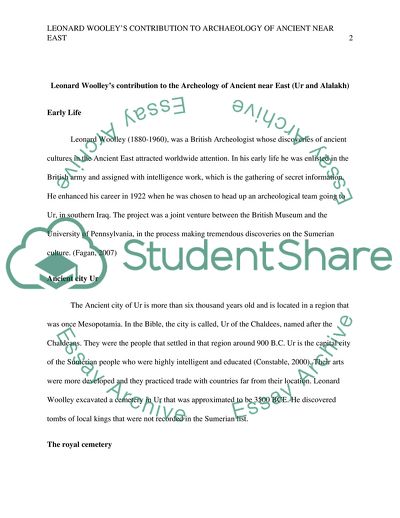Cite this document
(Leonard Woolleys Contribution to the Archeology of Ancient near East Essay Example | Topics and Well Written Essays - 1750 words, n.d.)
Leonard Woolleys Contribution to the Archeology of Ancient near East Essay Example | Topics and Well Written Essays - 1750 words. https://studentshare.org/archaeology/1818925-the-history-of-archaeological-exploration-in-the-ancient-near-east-select-a-19th-or-20th-century-archaeologist-and-discuss-the-ways-in-which-hisher-work-contributed-to-a-further-understanding-of-some-aspect-of-the-ancient-near-east-andor-the-ways-in
Leonard Woolleys Contribution to the Archeology of Ancient near East Essay Example | Topics and Well Written Essays - 1750 words. https://studentshare.org/archaeology/1818925-the-history-of-archaeological-exploration-in-the-ancient-near-east-select-a-19th-or-20th-century-archaeologist-and-discuss-the-ways-in-which-hisher-work-contributed-to-a-further-understanding-of-some-aspect-of-the-ancient-near-east-andor-the-ways-in
(Leonard Woolleys Contribution to the Archeology of Ancient Near East Essay Example | Topics and Well Written Essays - 1750 Words)
Leonard Woolleys Contribution to the Archeology of Ancient Near East Essay Example | Topics and Well Written Essays - 1750 Words. https://studentshare.org/archaeology/1818925-the-history-of-archaeological-exploration-in-the-ancient-near-east-select-a-19th-or-20th-century-archaeologist-and-discuss-the-ways-in-which-hisher-work-contributed-to-a-further-understanding-of-some-aspect-of-the-ancient-near-east-andor-the-ways-in.
Leonard Woolleys Contribution to the Archeology of Ancient Near East Essay Example | Topics and Well Written Essays - 1750 Words. https://studentshare.org/archaeology/1818925-the-history-of-archaeological-exploration-in-the-ancient-near-east-select-a-19th-or-20th-century-archaeologist-and-discuss-the-ways-in-which-hisher-work-contributed-to-a-further-understanding-of-some-aspect-of-the-ancient-near-east-andor-the-ways-in.
“Leonard Woolleys Contribution to the Archeology of Ancient Near East Essay Example | Topics and Well Written Essays - 1750 Words”. https://studentshare.org/archaeology/1818925-the-history-of-archaeological-exploration-in-the-ancient-near-east-select-a-19th-or-20th-century-archaeologist-and-discuss-the-ways-in-which-hisher-work-contributed-to-a-further-understanding-of-some-aspect-of-the-ancient-near-east-andor-the-ways-in.


